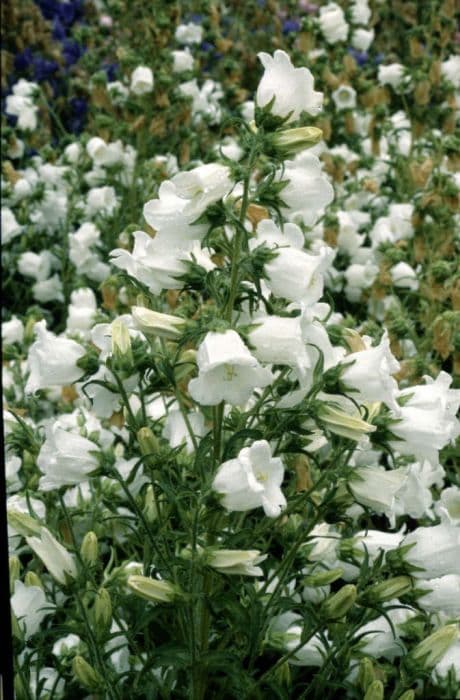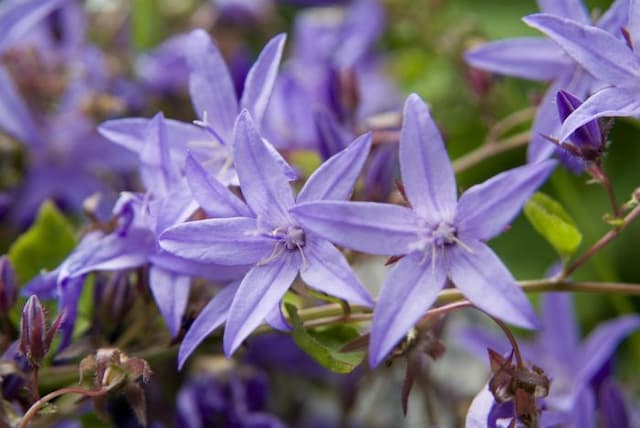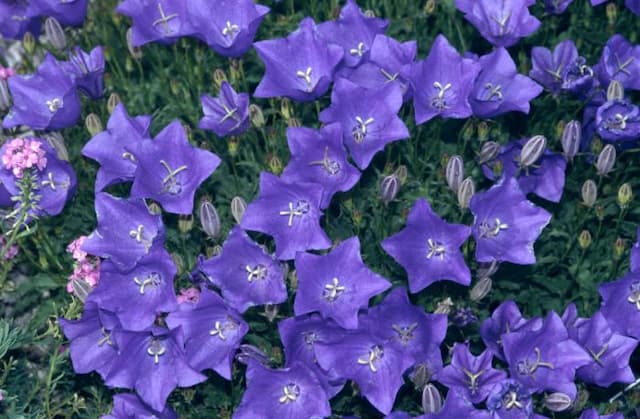Harbell Campanula 'Burghaltii'

ABOUT
Campanula 'Burghaltii', commonly known as the bellflower, is a charming and eye-catching perennial plant that is particularly noted for its beautiful flowers and foliage. The bellflower blooms with an abundance of bell-shaped flowers that come in a striking shade of violet-blue. The flowers are radiant and have a slight nodding habit, which adds to their whimsical appeal. Each flower comprises five petals that fuse to form the classic bell shape, and they typically cover the plant in a profuse display that can transform any garden space into a sea of blue. These blossoms offer a fairy-tale elegance to the plant and can attract various pollinators, including bees and butterflies, adding to the dynamic nature of the garden. The foliage of the bellflower is no less attractive, with leaves that are generally heart-shaped, boasting a lush green color. The texture of the leaves may feel slightly rough, with edges that can be either smooth or have a subtle serration. The leaves emerge from the base of the plant and ascend along the stems, creating a contrasting backdrop to the vibrant blue flowers. When planted en masse, Campanula 'Burghaltii' forms a delightful ground cover that brings color and vivacity to a garden setting. It is versatile and can be used in various garden designs, including borders, rockeries, and as underplanting for taller, more robust plants. Its ability to produce a long-lasting floral display makes it particularly appealing to gardeners looking to create a sustained impact in their garden throughout the flowering season. The bellflower is truly a picturesque plant, exuding grace with its bountiful blooms and pleasant greenery.
About this plant
 Names
NamesFamily
Campanulaceae
Synonyms
Bellflower, Chimney Bellflower
Common names
Campanula 'Burghaltii'.
 Toxicity
ToxicityTo humans
The Campanula 'Burghaltii', commonly known as the Bellflower, is not considered toxic to humans. Ingesting the plant typically does not result in serious consequences; however, individual sensitivities can vary, and it's always prudent to avoid ingesting any plant not intended for consumption.
To pets
The Bellflower is also not known to be toxic to pets. It is generally considered safe for cats and dogs, and ingestion usually does not lead to poisoning or serious health issues. Nonetheless, pet owners should always monitor their animals to prevent the ingestion of plants, as individual reactions can occur, and some pets may present with gastrointestinal upset if they consume plant matter they are not accustomed to.
 Characteristics
CharacteristicsLife cycle
Perennials
Foliage type
Deciduous
Color of leaves
Green
Flower color
Blue
Height
2 feet 60 cm
Spread
1 foot 30 cm
Plant type
Herb
Hardiness zones
5
Native area
Europe
Benefits
 General Benefits
General Benefits- Aesthetic Appeal: Adds visual interest to gardens with its bell-shaped flowers and lush foliage.
- Attracts Pollinators: Invites bees, butterflies, and other beneficial insects, supporting the local ecosystem.
- Low Maintenance: Requires minimal care once established, making it ideal for casual gardeners.
- Drought Tolerance: Can withstand periods of low water, fitting for gardens in arid climates or during water restrictions.
- Versatility: Suitable for garden beds, borders, containers, and as ground cover, offering a range of landscaping uses.
- Cold Hardy: Tolerates cooler temperatures, which makes it a good choice for gardens in temperate zones.
- Long Blooming Period: Provides flowers from late spring to early fall, offering prolonged seasonal interest.
- Edging Plant: Can be used to define garden paths and bed edges with its mounding growth habit.
- Rapid Growth: Quickly fills in garden spaces, which can help suppress weeds and reduce garden maintenance.
- Color Variety: Comes in a range of colors, allowing gardeners to choose the hues that best fit their garden palette.
 Medical Properties
Medical PropertiesThis plant is not used for medical purposes.
 Air-purifying Qualities
Air-purifying QualitiesThis plant is not specifically known for air purifying qualities.
 Other Uses
Other Uses- The bellflower 'Burghaltii' can be used in crafting and flower arrangement for its tall stems and vibrant blue flowers, adding height and color to bouquets or dried floral displays.
- The dried seeds of the bellflower can be embedded into handmade papers, giving them a decorative and textured appearance suitable for special invitations or greeting cards.
- Rolled leaves of the bellflower can be used in insect hotels as a natural material to provide nesting spaces for beneficial insects like solitary bees and lacewings.
- Pressed flowers of the bellflower can be used for botanical art, as they retain their color well, making them perfect for creating framed herbarium specimens or bookmarks.
- Photographers might use the bellflower in macro photography due to their intricate details and bell-shaped blossoms, allowing for visually stunning close-up images.
- The plant can be used in dyeing fabric or yarn, where the blossoms impart a light blue or grayish color depending on the mordant used in the process.
- The bellflower can add an unexpected twist to ice cubes or frozen desserts when small flowers are frozen inside, creating an attractive visual element for summer drinks or dishes.
- In garden design, the campanula 'Burghaltii' can be used as a natural border to guide pathways, due to its upright habit and dense foliage.
- Bellflower petals can be used to add color to potpourri mixes, combining their subtle hues with other dried flowers and scented herbs to create a pleasing aromatic blend.
- The plant's hollow stems can be creatively utilized as natural straws for garden parties, although they would be more decorative than functional.
Interesting Facts
 Feng Shui
Feng ShuiThe Bellflower is not used in Feng Shui practice.
 Zodiac Sign Compitability
Zodiac Sign CompitabilityThe Bellflower is not used in astrology practice.
 Plant Symbolism
Plant Symbolism- Constancy and perseverance: Campanula 'Burghaltii', commonly known as Bellflower, often symbolizes constancy and perseverance due to its hardy nature and ability to thrive in challenging conditions.
- Gratitude: The bell-shaped flowers of the Bellflower are also seen as a token of gratitude when given to someone, expressing thanks and appreciation.
- Affection: The Bellflower signifies affection, with the notion that the giver is fond of the recipient and is offering a gesture of love or friendship.
- Humility: The delicate appearance of the Bellflower can be associated with humility, suggesting modesty and unassuming grace.
 Water
WaterThe Clustered Bellflower should be watered regularly to maintain moist soil, especially during the growing season. It's best to water deeply once or twice a week, providing about one to one and a half gallons of water each time, depending on the weather and soil drainage. Less water may be needed during the winter months when the plant is not actively growing. Ensure that the pot or ground has good drainage to prevent waterlogging, as this can lead to root rot. Consistency is key to keeping these bellflowers healthy and thriving.
 Light
LightClustered Bellflower prefers full sun to partial shade conditions. An ideal spot would be one where the plant receives morning sunlight and some afternoon shade, especially in hotter climates. Placing it in a location with dappled sunlight under a high canopy or where it receives late afternoon sun can also be beneficial for the plant's growth and flower production.
 Temperature
TemperatureClustered Bellflower thrives in a range of temperatures but prefers moderate conditions. They perform well in temperatures between 60 to 75 degrees Fahrenheit. These bellflowers can generally tolerate temperatures as low as 50 degrees Fahrenheit and as high as 80 degrees Fahrenheit, but prolonged exposure outside this range can be harmful. It's important to protect the plant from extreme cold or heat.
 Pruning
PruningPruning Clustered Bellflower is important for maintaining its shape, encouraging new growth, and removing spent blooms to promote additional flowering. Deadheading should be done regularly during the blooming season. After the first flush of blooms, cut the plant back by about half to encourage a second bloom period. Prune the plant down to ground level at the end of the growing season or in early spring to prepare for new growth.
 Cleaning
CleaningAs needed
 Soil
SoilThe Bellflower 'Burghaltii' thrives best in well-draining soil that is rich in organic matter with a pH range of 6.0 to 7.5. A soil mix of equal parts loam, peat moss, and sharp sand or perlite provides good aeration and moisture retention while preventing waterlogging.
 Repotting
RepottingBellflower 'Burghaltii' should be repotted every 1 to 2 years or when it outgrows its current pot, to ensure continued growth and prevent root crowding. The best time to repot is in the spring.
 Humidity & Misting
Humidity & MistingBellflower 'Burghaltii' prefers moderate humidity levels, typical of what is found in average home environments. It does not require high humidity to thrive.
 Suitable locations
Suitable locationsIndoor
Place in bright light, avoid direct sun, keep soil moist.
Outdoor
Full sun to partial shade; protect from strong winds.
Hardiness zone
4-9 USDA
 Life cycle
Life cycleCampanula 'Burghaltii', commonly known as the Bellflower 'Burghaltii', begins its life cycle as seeds which, when sown and the right conditions are met, germinate and produce small seedlings. The seedlings develop true leaves and eventually form a rosette at the base. As they mature, these perennials send up flowering stalks which bear the characteristic bell-shaped flowers, usually in shades of blue to violet. After pollination, typically by bees or other insects attracted to the nectar, the flowers produce seeds, completing their reproductive cycle. The parent plant may die back in winter, especially in colder climates, but regrows from the rootstock or overwintering rosette the following spring. Over time, Bellflower 'Burghaltii' can also spread by basal offshoots, slowly expanding its presence in the garden.
 Propogation
PropogationPropogation time
Spring-early summer
Campanula 'Burghaltii', commonly known as Clustered Bellflower, is best propagated through division in the spring. This is when the plant is coming out of dormancy and has the season ahead to establish its roots well. The division should be done gently by taking the parent plant out of the ground or its container. Once it is out, shake off the excess soil, and using either your hands or a sharp knife, carefully separate the plant into sections, ensuring each has a portion of the root system. These sections can then be replanted in well-draining soil, spaced about 12 inches (approximately 30 centimeters) apart to accommodate for growth. Water the new plantings adequately to encourage root development. This popular method provides an effective and swift way to create new plants that will bloom within the same season.









